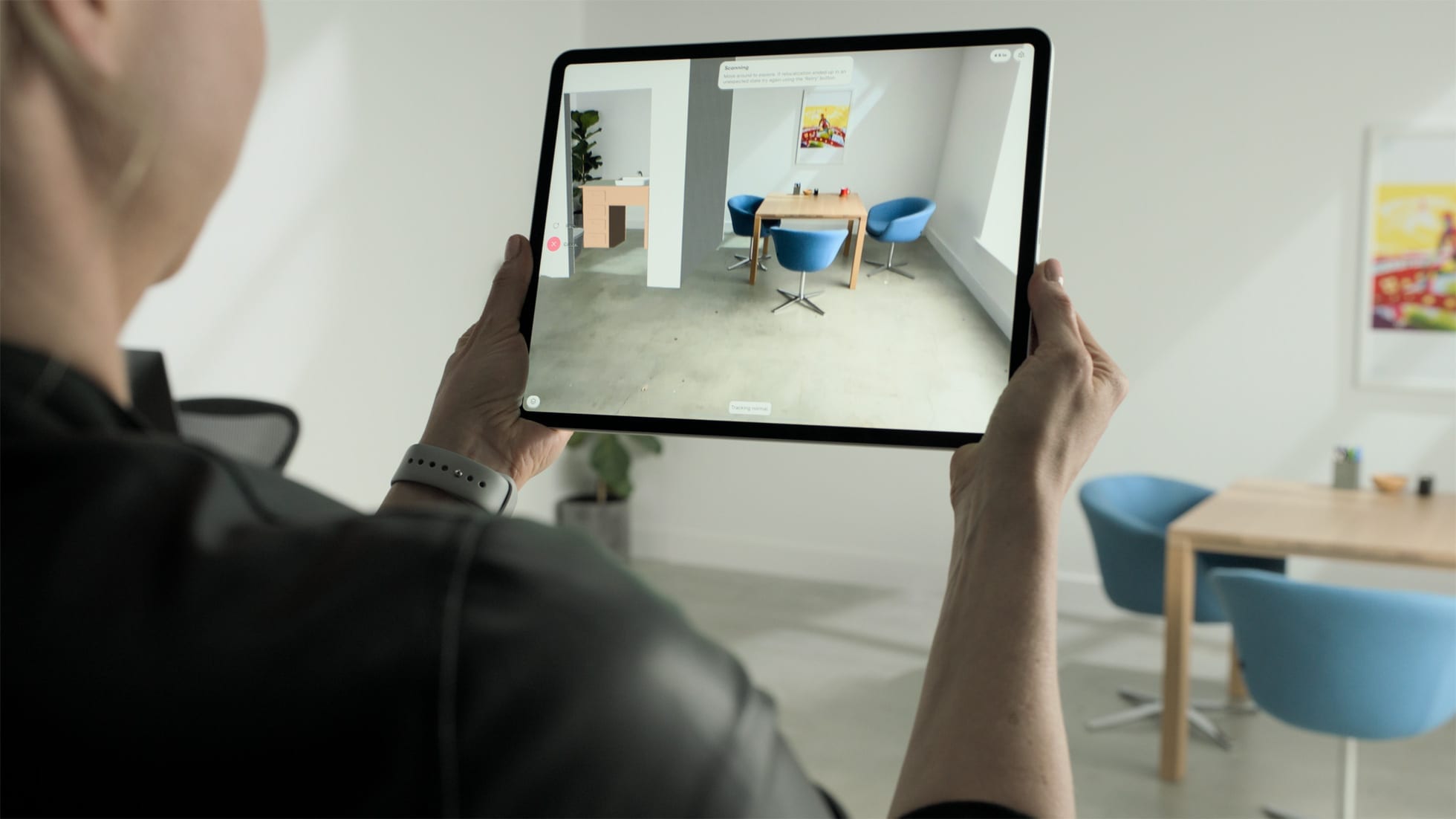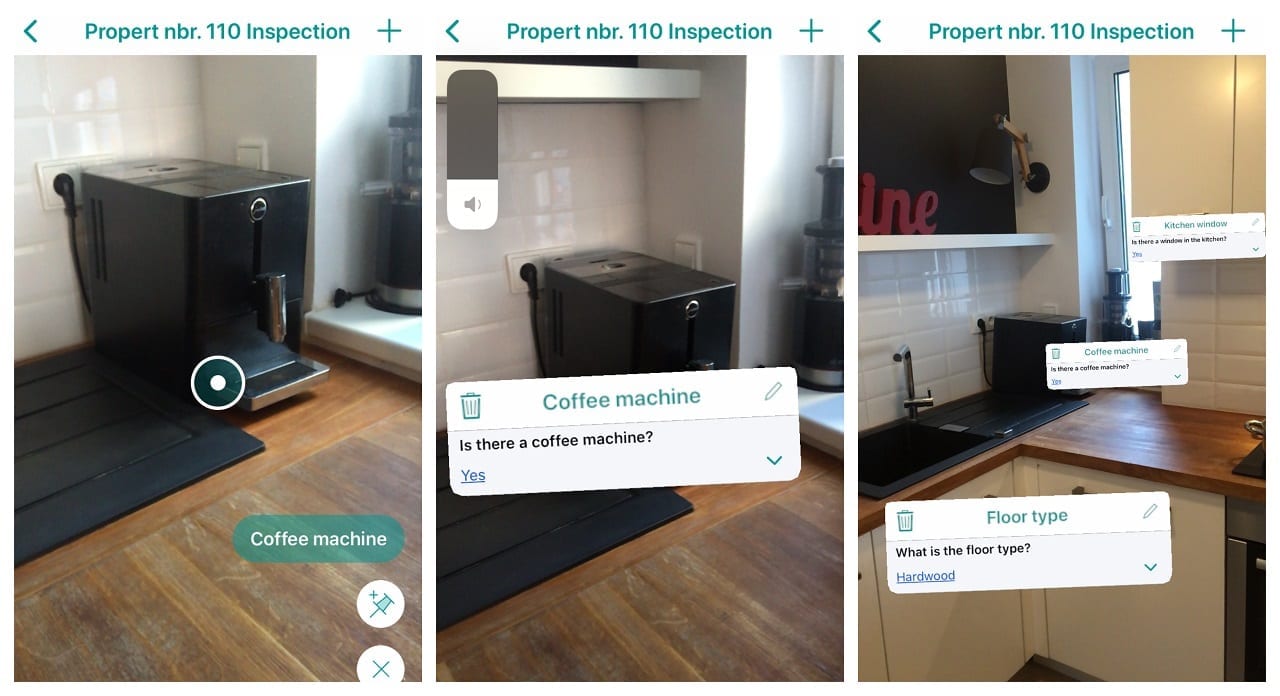Apple unveiled a new iPad Pro just a few days ago and it may have a lot to do with the future of augmented reality in enterprise. We say that because the hallmark of the device is the new LiDAR Scanner.
Located within the backside camera bump, it precisely measures the distance of viewed objects and provides unique AR functionality to the new iPad.
What this technology means for enterprises and how Resco thinks about the newest Apple innovation?
How LiDAR works
Apple uses LiDAR (which stands for Light Detection and Ranging) sensor on the new iPad Pro to improve the areas where standard cameras struggle – the measurement of the viewed objects and evaluating the depth of field.
LiDAR works by emitting light beams of the invisible infrared spectrum (usually 950 or 1550nm wavelengths) and measures the time it takes the photons to bounce from the objects and come back to the sensor. The whole process takes just nanoseconds.
Take a look at how iPad Pro’s LiDAR looks like under infrared:
Here is iPad Pro’s LiDAR under infrared. pic.twitter.com/IZkum3nwRx
— Faruk 🚀 ᴵᴾᴴᴼᴺᴱᴰᴼ (@iPhonedo) March 26, 2020
The main benefits of LiDAR utilization in iPad Pro are:
- Speed – Devices process LiDAR data very fast as they directly represent measurements;
- Low-light performance – As LiDAR uses infrared light, it performs well also in an environment with no ambient lighting;
- Accuracy and 3D modeling – Compared to a standard camera setup, LiDAR is much more precise in measuring the object distance and 3D modeling;
When technology maturity mixes with availability
The potential of Apple’s LiDAR to start an AR revolution lies in the combination of technology, price, and the resulting availability. We have already talked about its capabilities which dramatically improve the AR functionality. But what’s jut as important, is that iPad Pro starts at $799.
It’s not a bargain when we look at it as just as “a tablet,” but it’s a game-changer when we talk about the availability of LiDAR technology. Experts already predict that the next Pro versions of iPhone will also make use of the technology.
So millions will be carrying advanced AR devices right in their pockets. And that is a change making the AR revolution a major step closer.
But one more thing is needed to truly kick-start this revolution – quality software.
Apple has the power to provide advanced AR hardware to millions of users for an affordable price. But it can’t singlehandedly provide software solutions that would satisfy all needs of consumers and businesses.
That’s why Apple offers frameworks like ARKit and RealityKit, enabling developers to create apps and software suited for a specific use.
How Resco works on AR innovation
At Resco, we see augmented reality as one of the key innovations coming to enterprises in the upcoming years. So, we’re already developing our solutions with AR in mind.
Today, you use Resco Inspections on Microsoft HoloLens – AR smartglasses from Microsoft. This solution helps with tasks that require accuracy and precision by merging digital features into the physical world. It provides new possibilities for workers in terms of team collaboration and effectivity.
Take a look at how Tagged Image in Resco Inspections works:

But that’s not all. Next week, as part of the Resco Spring Update, we will unveil new AR functionality that will be available for iOS/iPadOS devices. With this solution, businesses will be able to utilize the AR capabilities of iPhones and iPads.
Resco’s AR Tagged Scene will enable inspectors, technicians, manufacturers, and any other professional to visualize their field of view and provide valuable information into the scene with interactive tags.
This will open up new possibilities for team collaboration, customer service, and will further streamline the completion of tasks by field workers.
With upcoming features, Resco brings the AR world to millions of people who already own the iPhone or iPad devices.
With expanding AR availability, BYOD policies also become a viable way for companies to start an AR revolution within their organization. And we are also already working on a technology that will take advantage of the new LiDAR in iPad Pro.
As augmented reality progresses rapidly in the field of enterprise utilization, let’s take a look at some of the scenarios with AR utilization we’re currently exploring.
AR enterprise use cases
Remote AR assistance
Augmented reality can be helpful in situations when a customer needs support with setting up or repairing a product. Today, it is often necessary to visit clients on-site, which costs time and money. With AR implementation, technicians can resolve cases while avoiding lengthy travel.
The basic scenario is efficient for both sides: an on-site customer starts a video call with a technician and explains the situation. As visual guides are more effective than just voice instructions, the technician instructs the customer with the help of AR.
He draws the instructions on the shared scene captured on a smartphone or tablet, and guides the client through the setup or maintenance process. With this help, technician and customers can easily and quickly collaborate on resolving an issue.

The AR video calls are applicable in a vast number of use cases. Even employees in healthcare, manufacturing, health & fitness, and others can utilize it to optimize remote collaboration with their colleagues and clients.
Interactive AR User Guides
Innovative solutions utilizing AR features can make the product manuals and user guides more effective, precise, and valuable for customers. Customers could scan products with a smartphone or tablet and see how to operate them.
Basic examples include coffee machines, dishwashers, or computers, but continue to more complex and specific products like repair equipment, or manufacturing machines.
AR Onboarding and Training
The onboarding processes of new employees can be tedious and ineffective, especially in demanding industries like manufacturing, maintenance, or field service. Complex work processes can make the trainee program time-consuming and difficult for newcomers and the company itself.
But AR tools can optimize and streamline these processes with interactive features and advance collaboration opportunities.
Thanks to mobile and easily available devices like iPhones and iPads, workers can get valuable information about the shop floor, specific setup/maintenance processes, or types of equipment directly while in the field.
With these insights available via AR guides, learning can be much easier and faster. Which enables organizations to optimize their trainee programs and related work processes.
Conclusion
Augmented reality is still not a standard in enterprise use. But new technology, like the LiDAR Scanner in iPad Pro, can speed up its integration. AR can help to train workers, optimize support provided to customers, or streamline various processes in manufacturing, field service, property inspections and others.
At Resco, we already work on these innovative solutions, so our partners and customers can utilize a cutting-edge technology to solve their pain points. If you want to learn more, you can start by taking a closer look at our Resco Inspections and ask for a demo.



